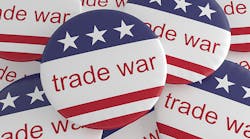Back in March when the Trump Administration announced tariffs on aluminum and steel, I mentioned that the tariffs would have other undesirable consequences such as rising prices for manufacturers and consumers who used those commodities, and would also result in tariffs on other imported American goods as a “tit for tat” move.
It’s easy to say that to mitigate these risks it helps to have a lean and agile supply chain and to perform scenario planning in advance, but what are some specific things we can do to combat this oncoming issue?
As per a recent Cleo blog, 53% of companies are highly or critically dependent on suppliers, according to Deloitte, meaning tariffs might lead companies to take measures to source new domestic suppliers.
So, new tariffs mean that companies are going to need to onboard new supply partners much faster than in the past, involving configuring partner profiles and connections to securely exchange order, invoicing, shipping and payment data.
To truly enable a lean and agile supply chain, legacy systems and custom coding cannot support onboarding new customers in a timely and effective fashion, and such disparate technologies silo the critical data flows and hinder visibility into daily business processes.
World-class supply chains have onboarding and visibility capabilities built into their systems, reducing the complexity and cost of partner onboarding and enabling holistic views into data. These systems support cloud, B2B and application integration improves partner communications and transparency.
While these tariffs are a cause for concern, change is always present. Companies might not be able to control protectionist measures that will affect supply costs, but they can control the technology that enables their supply chain to improve customer service and contain costs to some degree.
Furthermore, global supply chains emerged in an era of falling tariffs, that may now be coming to an end amid an upsurge in protectionism. However, according to Matt Mossman from Mainpointe, experience suggests that in most economic sectors, supply chains do not need to change substantially in the face of protectionism, that only small adjustments need to be made, allowing most companies to maintain operations and avoid major increases in the cost of their goods, since:
• “Global supply chains have multiple variable costs, and research shows that when some of those costs rise, suppliers often choose to absorb them and remain in the supply chain.
• “Some companies pass on higher costs to retail customers, and the strong global economy could help consumers absorb small price increases caused by increased tariffs.
• “In the longer term, companies worried about protectionism may prioritize risk management over cost savings by focusing on regional rather than global supply strategies.”
If all else fails, you might want to consider insurance. Some of the types available, according to riskandinsurance.com, include:
Trade disruption insurance: Protects a company’s income in the event their supply chain is disrupted due to risks such as war, embargos and government actions restricting exports.
Contract frustration insurance: Protects a company’s account receivables if it has a contract with a government buyer and is concerned that it may not get paid due to credit concerns or political risk.
Expropriation: Covers interference such as political retaliation from a foreign government halting the ability of the company to operate.
As they say, sometimes the best offense is a good defense.




